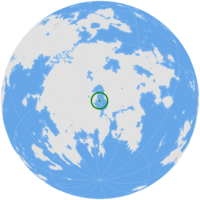Paxaklemtorno
This article is incomplete because it is pending further input from participants, or it is a work-in-progress by one author. Please comment on this article's talk page to share your input, comments and questions. Note: To contribute to this article, you may need to seek help from the author(s) of this page. |
Kingdoms of Paxaklemtorno | |
|---|---|
| Motto: Numixaseredenjixaseol Free of bonds, free of pain | |
| Anthem: Selessmapexliana Sea of Stars | |
 Location of Paxaklemtorno in Anteria | |
| Capital | Niquenunipe |
| Official languages | Tqennin Auawan-Setumun |
| Ethnic groups (2020) | 54% Tqennu 22% Au 14% Setumue 8% Foreign Nationals 2% Other |
| Religion (2020) | 97% Qwesmenu 2% Christianity 1% Other |
| Demonym(s) | Passashan |
| Government | Federal semi-direct assembly-moderated democracy under an executive constitutional monarchy |
• Queen | Pexurtimu mwa XIX |
| Weteru Uahn | |
| Legislature | Federal Mdxlis |
| Council of Corners | |
| Popular Assembly | |
| Formation | |
| June 7th, 1232 BC | |
| August 23rd, 277 BC | |
| January 2nd, 571 | |
| November 7th, 1663 | |
| Area | |
• Total | 17,784 km2 (6,866 sq mi) |
| Population | |
• 2021 estimate | 7,100,000 |
• 2019 census | 7,024,680 |
• Density | 395/km2 (1,023.0/sq mi) |
| GDP (PPP) | 2019 estimate |
• Total | 464,046 billion ACU |
• Per capita | 67,483 ACU |
| Gini (2019) | low |
| HDI (2019) | very high |
| Currency | Passashan kernel (PXK) |
| Time zone | UTC-2 (PUT) |
| Driving side | right |
| Calling code | +909 |
| Internet TLD | .xp |
Paxaklemtorno (Passashi Phonetic: Passashlemtorna), or the Kingdoms of Paxaklemtorno, is an island nation in Northern Thrismari. Paxaklemtorno is surrounded by the Marmor Sea, an internal sea of the Kaldaz Ocean, though it borders the island possessions of Encessia in the west and Senshen in the north. Paxaklemtorno spans an archipelago of the same name, housing its greatly urbanised population. The capital of the Kingdoms, Niquenunipe, in which both the civil and the royal governments are located, is one of the jewels of the island of Waqa, which itself is the largest island of Paxaklemtorno.
The first mentions of the Kingdoms go as far back as the first millenium BC, with the earliest signs of paleohuman activity suggesting that modern Paxaklemtorno has been inhabited since the Old Stone Age. The legendary first monarch of the Kingdoms, Wqxm'pt, is credited with establishing the extant lineage of kings and queens during the 20th century BC. The earliest verified monarch, however, has lived around the 13th century BC, a date that is confirmed by various finds from the era that suggest the existence of a loose government over the island of Waqa. The Younger Kingdoms have enjoyed a unique power divide, one that was devised to maintain stability for the monarchy and prosperity for its subjects. Towards the 3rd century BC, the internal conflicts coming from that divide have resulted in a civil strife. In turn, this caused a period of Wars of the Isles to come into being, during which the features of the Current Kingdoms were finally defined. The unique social and political structures have ostracized Paxaklemtorno, which became evident in the 10th century, causing it to enter a full isolation. It was in effect until the Day of Open Ports, led by Encessia and the other powers of the Marmor Sea, after which the Kingdoms of Paxaklemtorno have entered a steep decline, following the forced reforms in the country and attempts to overthrow local rule. Ten Days of Xaxuaki and the diplomatic eminence of Passashan monarchs, specifically Queen Henipua, heralded the transformation of the Kingdoms from a largely agrarian society to an industrial polity, to a prosperous "periphery" country and, in the 20th century, to a developed nationstate. The tendency for neutralism, which became evident in the 19th century, defines contemporary external affairs of Paxaklemtorno, though recent monarchs and governments have shown a keen interest in developing an active foreign policy. Paxaklemtorno partakes in various regional and international organisations, but it isn't an official member of any of them, including the AWA, though it has signed a series of bilateral treaties with the latter, all defining the place of the state within the framework of modern Global Relations.
Culture...
Economy...
Etymology
WIP
History
WIP
Geography
WIP
Politics
WIP
Economy
WIP
Culture
WIP
Demographics
WIP
See also
WIP
Notes and references
WIP

